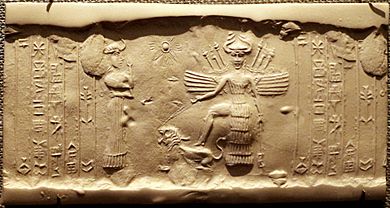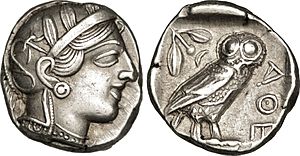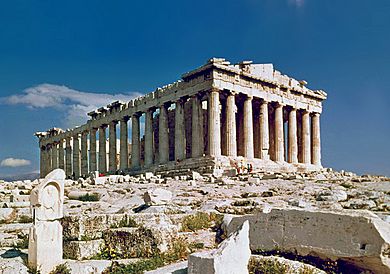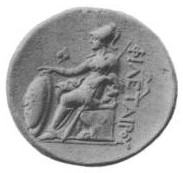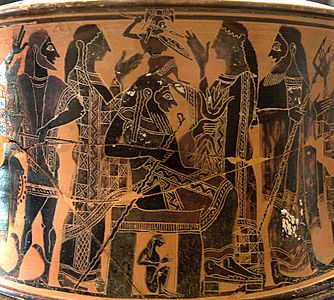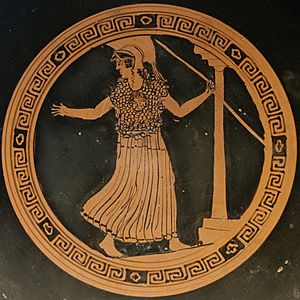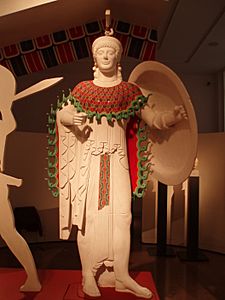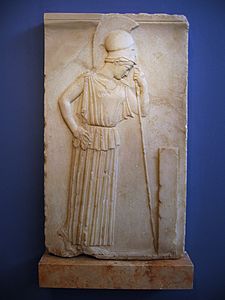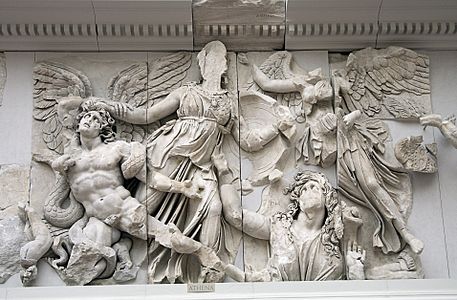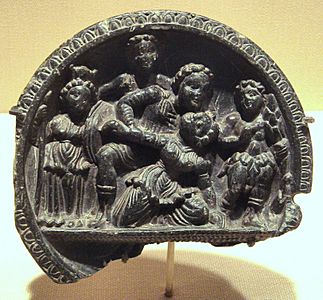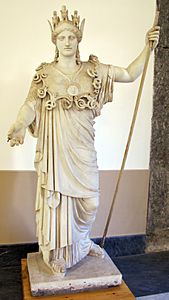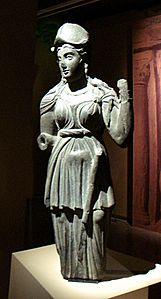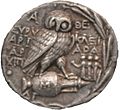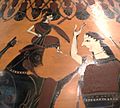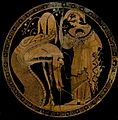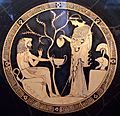Athena facts for kids
Quick facts for kids Athena |
|
|---|---|
| Goddess of wisdom, handicraft, heroism, courage, war, strategy, industry, and cities | |
| Member of the Twelve Olympians | |

Mattei Athena at Louvre. Roman copy from the 1st century BC/AD after a Greek original of the 4th century BC, attributed to Cephisodotos or Euphranor.
|
|
| Abode | Mount Olympus |
| Animals | owl, serpent, spider, horse |
| Symbol | Aegis, helmet, spear, armor, Gorgoneion, chariot, distaff |
| Tree | Olive |
| Personal information | |
| Children | Erichthonius (adopted) |
| Parents | Zeus and Metis |
| Siblings | Aeacus, Angelos, Aphrodite, Apollo, Ares, Artemis, Dionysus, Eileithyia, Enyo, Eris, Ersa, Hebe, Helen of Troy, Hephaestus, Heracles, Hermes, Minos, Pandia, Persephone, Perseus, Rhadamanthus, the Graces, the Horae, the Litae, the Muses, the Moirai |
| Equivalents | |
| Roman equivalent | Minerva |
| Etruscan equivalent | Menrva |
| Hinduism equivalent | Sarasvati |
| Canaanite equivalent | Anat |
| Egyptian equivalent | Neith |
| Celtic equivalent | Sulis |
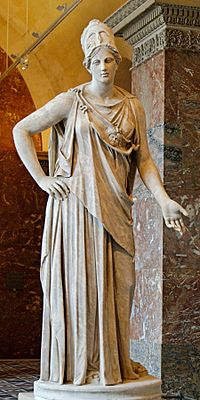
Athena or Athene, often given the epithet Pallas, is an ancient Greek goddess associated with wisdom, handicraft, and warfare who was later syncretized with the Roman goddess Minerva. Athena was regarded as the patron and protectress of various cities across Greece, particularly the city of Athens, from which she most likely received her name. The Parthenon on the Acropolis of Athens is dedicated to her. Her major symbols include owls, olive trees, snakes, and the Gorgoneion. In art, she is generally depicted wearing a helmet and holding a spear.
From her origin as an Aegean palace goddess, Athena was closely associated with the city. She was known as Polias and Poliouchos (both derived from polis, meaning "city-state"), and her temples were usually located atop the fortified acropolis in the central part of the city. The Parthenon on the Athenian Acropolis is dedicated to her, along with numerous other temples and monuments. As the patron of craft and weaving, Athena was known as Ergane. She was also a warrior goddess, and was believed to lead soldiers into battle as Athena Promachos. Her main festival in Athens was the Panathenaia, which was celebrated during the month of Hekatombaion in midsummer and was the most important festival on the Athenian calendar.
In Greek mythology, Athena was believed to have been born from the forehead of her father Zeus. In some versions of the story, Athena has no mother and is born from Zeus' forehead by parthenogenesis. In others, such as Hesiod's Theogony, Zeus swallows his consort Metis, who was pregnant with Athena; in this version, Athena is first born within Zeus and then escapes from his body through his forehead. In the founding myth of Athens, Athena bested Poseidon in a competition over patronage of the city by creating the first olive tree. She was known as Athena Parthenos "Athena the Virgin". Athena was the patron goddess of heroic endeavor; she was believed to have aided the heroes Perseus, Heracles, Bellerophon, and Jason. Along with Aphrodite and Hera, Athena was one of the three goddesses whose feud resulted in the beginning of the Trojan War.
Contents
Etymology
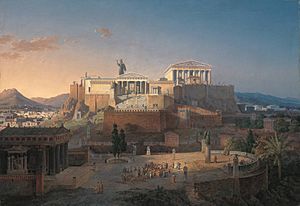
Athena is associated with the city of Athens. The name of the city in ancient Greek is Ἀθῆναι (Athȇnai), a plural toponym, designating the place where—according to myth—she presided over the Athenai, a sisterhood devoted to her worship. In ancient times, scholars argued whether Athena was named after Athens or Athens after Athena. Now scholars generally agree that the goddess takes her name from the city; the ending -ene is common in names of locations, but rare for personal names. Testimonies from different cities in ancient Greece attest that similar city goddesses were worshipped in other cities and, like Athena, took their names from the cities where they were worshipped. For example, in Mycenae there was a goddess called Mykene, whose sisterhood was known as Mykenai, whereas at Thebes an analogous deity was called Thebe, and the city was known under the plural form Thebai (or Thebes, in English, where the 's' is the plural formation). The name Athenai is likely of Pre-Greek origin because it contains the presumably Pre-Greek morpheme *-ān-.
In his dialogue Cratylus, the ancient Greek philosopher Plato (428–347 BC) gives some rather imaginative etymologies of Athena's name, based on the theories of the ancient Athenians and his own etymological speculations:
That is a graver matter, and there, my friend, the modern interpreters of Homer may, I think, assist in explaining the view of the ancients. For most of these in their explanations of the poet, assert that he meant by Athena "mind" [νοῦς, noũs] and "intelligence" [διάνοια, diánoia], and the maker of names appears to have had a singular notion about her; and indeed calls her by a still higher title, "divine intelligence" [θεοῦ νόησις, theoũ nóēsis], as though he would say: This is she who has the mind of God [ἁ θεονόα, a theonóa]. Perhaps, however, the name Theonoe may mean "she who knows divine things" [τὰ θεῖα νοοῦσα, ta theia noousa] better than others. Nor shall we be far wrong in supposing that the author of it wished to identify this Goddess with moral intelligence [εν έθει νόεσιν, en éthei nóesin], and therefore gave her the name Etheonoe; which, however, either he or his successors have altered into what they thought a nicer form, and called her Athena.
Thus, Plato believed that Athena's name was derived from Greek Ἀθεονόα, Atheonóa—which the later Greeks rationalised as from the deity's (θεός, theós) mind (νοῦς, noũs). The second-century AD orator Aelius Aristides attempted to derive natural symbols from the etymological roots of Athena's names to be aether, air, earth, and moon.
Origins
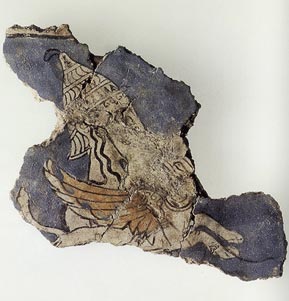
Athena was originally the Aegean goddess of the palace, who presided over household crafts and protected the king. A single Mycenaean Greek inscription 𐀀𐀲𐀙𐀡𐀴𐀛𐀊 a-ta-na po-ti-ni-ja appears at Knossos in the Linear B tablets from the Late Minoan II-era "Room of the Chariot Tablets"; these comprise the earliest Linear B archive anywhere. Although Athana potnia is often translated as "Mistress Athena", it could also mean "the Potnia of Athana", or the Lady of Athens. However, any connection to the city of Athens in the Knossos inscription is uncertain. A sign series a-ta-no-dju-wa-ja appears in the still undeciphered corpus of Linear A tablets, written in the unclassified Minoan language. This could be connected with the Linear B Mycenaean expressions a-ta-na po-ti-ni-ja and di-u-ja or di-wi-ja (Diwia, "of Zeus" or, possibly, related to a homonymous goddess), resulting in a translation "Athena of Zeus" or "divine Athena". Similarly, in the Greek mythology and epic tradition, Athena figures as a daughter of Zeus (Διός θυγάτηρ; cfr. Dyeus). However, the inscription quoted seems to be very similar to "a-ta-nū-tī wa-ya", quoted as SY Za 1 by Jan Best. Best translates the initial a-ta-nū-tī, which is recurrent in line beginnings, as "I have given".
A Mycenean fresco depicts two women extending their hands towards a central figure, who is covered by an enormous figure-eight shield; this may depict the warrior-goddess with her palladion, or her palladion in an aniconic representation. In the "Procession Fresco" at Knossos, which was reconstructed by the Mycenaeans, two rows of figures carrying vessels seem to meet in front of a central figure, which is probably the Minoan precursor to Athena. The early twentieth-century scholar Martin Persson Nilsson argued that the Minoan snake goddess figurines are early representations of Athena.
Nilsson and others have claimed that, in early times, Athena was either an owl herself or a bird goddess in general. In the third book of the Odyssey, she takes the form of a sea-eagle. Proponents of this view argue that she dropped her prophylactic owl-mask before she lost her wings. "Athena, by the time she appears in art," Jane Ellen Harrison remarks, "has completely shed her animal form, has reduced the shapes she once wore of snake and bird to attributes, but occasionally in black-figure vase-paintings she still appears with wings."
It is generally agreed that the cult of Athena preserves some aspects of the Proto-Indo-European transfunctional goddess. The cult of Athena may have also been influenced by those of Near Eastern warrior goddesses such as the East Semitic Ishtar and the Ugaritic Anat, both of whom were often portrayed bearing arms. Classical scholar Charles Penglase notes that Athena resembles Inanna in her role as a "terrifying warrior goddess" and that both goddesses were closely linked with creation. Athena's birth from the head of Zeus may be derived from the earlier Sumerian myth of Inanna's descent into and return from the Underworld.
Plato notes that the citizens of Sais in Egypt worshipped a goddess known as Neith, whom he identifies with Athena. Neith was the ancient Egyptian goddess of war and hunting, who was also associated with weaving; her worship began during the Egyptian Pre-Dynastic period. In Greek mythology, Athena was reported to have visited mythological sites in North Africa, including Libya's Triton River and the Phlegraean plain. Based on these similarities, the Sinologist Martin Bernal created the "Black Athena" hypothesis, which claimed that Neith was brought to Greece from Egypt, along with "an enormous number of features of civilization and culture in the third and second millennia". The "Black Athena" hypothesis stirred up widespread controversy near the end of the twentieth century, but it has now been widely rejected by modern scholars.
Cult and patronages
Panhellenic and Athenian cult
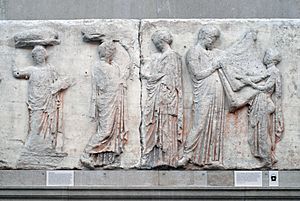
In her aspect of Athena Polias, Athena was venerated as the goddess of the city and the protectress of the citadel. In Athens, the Plynteria, or "Feast of the Bath", was observed every year at the end of the month of Thargelion. The festival lasted for five days. During this period, the priestesses of Athena, or plyntrídes, performed a cleansing ritual within the Erechtheion, a sanctuary devoted to Athena and Poseidon. Here Athena's statue was undressed, her clothes washed, and body purified. Athena was worshipped at festivals such as Chalceia as Athena Ergane, the patroness of various crafts, especially weaving. She was also the patron of metalworkers and was believed to aid in the forging of armor and weapons. During the late fifth century BC, the role of goddess of philosophy became a major aspect of Athena's cult.
As Athena Promachos, she was believed to lead soldiers into battle. Athena represented the disciplined, strategic side of war, in contrast to her brother Ares, the patron of violence, bloodlust, and slaughter—"the raw force of war". Athena was believed to only support those fighting for a just cause and was thought to view war primarily as a means to resolve conflict. The Greeks regarded Athena with much higher esteem than Ares. Athena was especially worshipped in this role during the festivals of the Panathenaea and Pamboeotia, both of which prominently featured displays of athletic and military prowess. As the patroness of heroes and warriors, Athena was believed to favor those who used cunning and intelligence rather than brute strength.
In her aspect as a warrior maiden, Athena was known as Parthenos (Παρθένος "virgin"), because, like her fellow goddesses Artemis and Hestia, she was believed to remain perpetually a virgin. Athena's most famous temple, the Parthenon on the Athenian Acropolis, takes its name from this title. According to Karl Kerényi, a scholar of Greek mythology, the name Parthenos is not merely an observation of Athena's virginity, but also a recognition of her role as enforcer of rules of modesty and ritual mystery.
Regional cults
Athena was not only the patron goddess of Athens, but also other cities, including Argos, Sparta, Gortyn, Lindos, and Larisa. The various cults of Athena were all branches of her panhellenic cult and often proctored various initiation rites of Grecian youth, such as the passage into citizenship by young men or the passage of young women into marriage. These cults were portals of a uniform socialization, even beyond mainland Greece. Athena was frequently equated with Aphaea, a local goddess of the island of Aegina, originally from Crete and also associated with Artemis and the nymph Britomartis. In Arcadia, she was assimilated with the ancient goddess Alea and worshiped as Athena Alea. Sanctuaries dedicated to Athena Alea were located in the Laconian towns of Mantineia and Tegea. The temple of Athena Alea in Tegea was an important religious center of ancient Greece. The geographer Pausanias was informed that the temenos had been founded by Aleus.
Athena had a major temple on the Spartan Acropolis, where she was venerated as Poliouchos and Khalkíoikos ("of the Brazen House", often latinized as Chalcioecus). This epithet may refer to the fact that cult statue held there may have been made of bronze, that the walls of the temple itself may have been made of bronze, or that Athena was the patron of metal-workers. Bells made of terracotta and bronze were used in Sparta as part of Athena's cult. An Ionic-style temple to Athena Polias was built at Priene in the fourth century BC. It was designed by Pytheos of Priene, the same architect who designed the Mausoleum at Halicarnassus. The temple was dedicated by Alexander the Great and an inscription from the temple declaring his dedication is now held in the British Museum.
Classical art
Athena appears frequently in classical Greek art, including on coins and in paintings on ceramics. She is especially prominent in works produced in Athens. In classical depictions, Athena is usually portrayed standing upright, wearing a full-length chiton. She is most often represented dressed in armor like a male soldier and wearing a Corinthian helmet raised high atop her forehead. Her shield bears at its centre the aegis with the head of the gorgon (gorgoneion) in the center and snakes around the edge. Sometimes she is shown wearing the aegis as a cloak. As Athena Promachos, she is shown brandishing a spear. Scenes in which Athena was represented include her birth from the head of Zeus, her battle with the Gigantes, the birth of Erichthonius, and the Judgement of Paris.
The Mourning Athena or Athena Meditating is a famous relief sculpture dating to around 470-460 BC that has been interpreted to represent Athena Polias. The most famous classical depiction of Athena was the Athena Parthenos, a now-lost 11.5 m (38 ft) gold and ivory statue of her in the Parthenon created by the Athenian sculptor Phidias. Copies reveal that this statue depicted Athena holding her shield in her left hand with Nike, the winged goddess of victory, standing in her right. Athena Polias is also represented in a Neo-Attic relief now held in the Virginia Museum of Fine Arts, which depicts her holding an owl in her hand and wearing her characteristic Corinthian helmet while resting her shield against a nearby herma. The Roman goddess Minerva adopted most of Athena's Greek iconographical associations, but was also integrated into the Capitoline Triad.
-
Attic red-figure kylix of Athena Promachos holding a spear and standing beside a Doric column (c. 500-490 BC)
-
Restoration of the polychrome decoration of the Athena statue from the Aphaea temple at Aegina, c. 490 BC (from the exposition "Bunte Götter" by the Munich Glyptothek)
-
Relief of Athena and Nike slaying the Gigante Alkyoneus (?) from the Gigantomachy Frieze on the Pergamon Altar (early second century BC)
-
Classical mosaic from a villa at Tusculum, 3rd century AD, now at Museo Pio-Clementino, Vatican
-
Athena portrait by Eukleidas on a tetradrachm from Syracuse, Sicily c. 400 BC
-
Athena (2nd century BC) in the art of Gandhara, displayed at the Lahore Museum, Pakistan
Images for kids
-
Athena is "born" from Zeus's forehead as a result of him having swallowed her mother Metis, as he grasps the clothing of Eileithyia on the right; black-figured amphora, 550–525 BC, Louvre.
-
The Varvakeion Athena, the most faithful copy of the Athena Parthenos, as displayed in the National Archaeological Museum, Athens.
-
The Dispute of Minerva and Neptune by René-Antoine Houasse (c. 1689 or 1706)
-
Attic red-figure kylix painting from c. 480-470 BC showing Athena observing as the Colchian dragon disgorges the hero Jason
-
Classical Greek depiction of Medusa from the fourth century BC
-
Minerva and Arachne by René-Antoine Houasse (1706)
-
Ancient Greek mosaic from Antioch dating to the second century AD, depicting the Judgement of Paris
-
Silver coin showing Athena with Scylla decorated helmet and Heracles fighting the Nemean lion (Heraclea Lucania, 390-340 BC)
-
Pallas and the Centaur (c. 1482) by Sandro Botticelli
-
Minerva Expelling the Vices from the Garden of Virtue (1502) by Andrea Mantegna
-
Pallas Athena (c. 1655) by Rembrandt
-
Minerva and the Triumph of Jupiter (1706) by René-Antoine Houasse
-
Minerva Fighting Mars (1771) by Jacques-Louis David
-
Minerva of Peace mosaic in the Library of Congress
See also
 In Spanish: Atenea para niños
In Spanish: Atenea para niños



